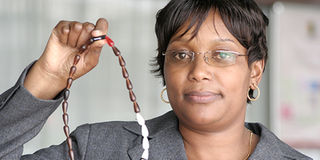Beads to aid in family planning

Researcher Caroline Mackenzie shows the necklace designed to help women keep track of their menstrual cycle in an interview on Thursday. Photo/JAMES NJUGUNA
What you need to know:
- Counting on coloured string to appeal to women who do not like using the calendar
Women in search of an easier way to keep track of their menstrual cycle with the aim of planning their families now have a reason to smile.
A colour-coded string of beads called CycleBeads, which resembles a multi-coloured necklace, will assist women to count their cycle days.
The Standard Days Method was developed last year by two American research institutions in collaboration with Family Health International-Kenya in a bid to bridge the country’s unmet contraception needs.
“Women only need to note the changes in the colour of the beads to distinguish their fertile and safe days,” said Ms Caroline Mackenzie, a research associate involved in the study.
Using the beads, a woman can track her cycle and anticipate when pregnancy is most likely to occur between cycle days eight to 19.
A red bead marks the first day of the menstrual period and the woman is expected to move a small elastic band on the beads every day to track her fertility.
Twelve white beads represent fertile days, whereas the brown ones indicate days when pregnancy cannot occur.
The concept, developed by researchers at Georgetown University is already in use among women in Ijara District, North Eastern Province.
The method is on exhibition at the 8th International Conference on Urban Health which ends today at the KICC, Nairobi. Delegates from more than 40 countries are attending.
Side effects
Ms Mackenzie recommends the method due to its suitability among women who are concerned about side effects or are bound by religion and culture dictates that prohibit other methods.
“The method is more than 95 per cent effective at preventing unwanted pregnancy without the side effects sometimes experienced with hormonal methods,” she said.
Ms Mackenzie says the method is fairly easy to use and suitable for women who do not want to mark dates on calendars or manually counting their cycle days.
Women with regular menstrual cycles that range from 26 to 32 days can use the method.
“The contraceptive method, however, is not readily available in health facilities, though we are working to get it to the women soonest,” added the researcher.
The method that compares to a decorative necklace costs Sh70, making it affordable for most women in the country.
To date, research shows that modern family planning methods have failed to meet women’s contraceptive needs in Kenya with women giving varied reasons for discontinuing a method.
“Ijara District was the first district in the country to adopt this method because, of low FP uptake among women in the area given the low literacy rates,” Ms Mackenzie said.
The method, which requires minimal clinic visits also empowered women to take charge of their families better. Last month, the World Health Organisation urged the government to increase accessibility of contraceptives to women.
Currently, the need for contraception in Kenya stands at 25 per cent largely due to myths, misconceptions, unavailability and cost of family planning methods at the sub-district hospitals, dispensaries and clinics.




